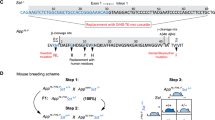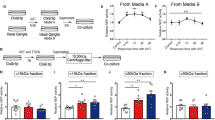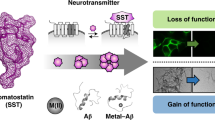Abstract
Expression of somatostatin in the brain declines during aging in various mammals including apes and humans1,2. A prominent decrease in this neuropeptide also represents a pathological characteristic of Alzheimer disease3,4. Using in vitro and in vivo paradigms, we show that somatostatin regulates the metabolism of amyloid β peptide (Aβ), the primary pathogenic agent of Alzheimer disease, in the brain through modulating proteolytic degradation catalyzed by neprilysin. Among various effector candidates, only somatostatin upregulated neprilysin activity in primary cortical neurons. A genetic deficiency of somatostatin altered hippocampal neprilysin activity and localization, and increased the quantity of a hydrophobic 42-mer form of Aβ, Aβ42, in a manner similar to presenilin gene mutations that cause familial Alzheimer disease. These results indicate that the aging-induced downregulation of somatostatin expression may be a trigger for Aβ accumulation leading to late-onset sporadic Alzheimer disease, and suggest that somatostatin receptors may be pharmacological-target candidates for prevention and treatment of Alzheimer disease.
This is a preview of subscription content, access via your institution
Access options
Subscribe to this journal
Receive 12 print issues and online access
$209.00 per year
only $17.42 per issue
Buy this article
- Purchase on Springer Link
- Instant access to full article PDF
Prices may be subject to local taxes which are calculated during checkout




Similar content being viewed by others
References
Hayashi, M., Yamashita, A. & Shimizu, K. Somatostatin and brain-derived neurotrophic factor mRNA expression in the primate brain: decreased levels of mRNA during aging. Brain Res. 749, 283–289 (1997).
Lu, T. et al. Gene regulation and DNA damage in the ageing human brain. Nature 429, 883–891 (2004).
Davies, P., Katzman, R. & Terry, R.D. Reduced somatostatin-like immunoreactivity in cerebral cortex from cases of Alzheimer's disease and Alzheimer senile dementia. Nature 288, 279–280 (1980).
van de Nes, J.A.P., Sandmann-Keil, D. & Braak, H. Interstitial cells subjacent to the entorhinal region expressing somatostatin-28 immunoreactivity are susceptible to development of Alzheimer's disease–related cytoskeletal changes. Acta Neuropathol. 104, 351–356 (2002).
Hardy, J. & Selkoe, D.J. The amyloid hypothesis of Alzheimer's disease: progress and problems on the road to therapeutics. Science 297, 353–356 (2002).
Iwata, N. et al. (2000). Identification of the major Aβ1 – 42-degrading catabolic pathway in brain parenchyma: Suppression leads to biochemical and pathological deposition. Nat. Med. 6, 143–151 (2000).
Iwata, N. et al. Metabolic regulation of brain Aβ by neprilysin. Science 292, 1550–1552 (2001).
Iwata, N., Takaki, Y., Fukami, S., Tsubuki, S. & Saido, T.C. Region-specific reduction of Aβ-degrading endopeptidase, neprilysin, in mouse hippocampus upon aging. J. Neurosci. Res. 70, 493–500 (2002).
Yasojima, K., Akiyama, H., McGeer, E.G. & McGeer, P.L. Reduced neprilysin in high plaque areas of Alzheimer brain: a possible relationship to deficient degradation of β-amyloid peptide. Neurosci. Lett. 297, 97–100 (2001).
Leissring, M.A. et al. Enhanced proteolysis of β-amyloid in APP transgenic mice prevents plaque formation, secondary pathology, and premature death. Neuron 40, 1087–1093 (2003).
Iwata, N. et al. Presynaptic localization of neprilysin contributes to efficient clearance of amyloid-β peptide in mouse brain. J. Neurosci. 24, 991–998 (2004).
Wang, T.-L., Chang, H., Hung, C.-R. & Tseng, Y.-Z. Morphine preconditioning attenuates neutrophil activation in rat models of myocardial infarction. Cardiovasc. Res. 40, 557–563 (1998).
Joshi, D.D. et al. Negative feedback on the effect of stem cell factor on hematopoiesis is partly mediated through neutral endopeptidase activity on substance P: a combined functional and proteomic study. Blood 98, 2697–2706 (2001).
Hama, E., Shirotani, K., Iwata, N. & Saido, T.C. Effects of neprilysin chimeric proteins targeted to subcellular compartments on amyloid β peptide clearance in primary neurons. J. Biol. Chem. 279, 30259–30269 (2004).
Shirotani, K. et al. Neprilysin degrades both amyloid β peptides 1–40 and 1–42 most rapidly and efficiently among thiorphan- and phosphoramidon-sensitive endopeptidases. J. Biol. Chem. 276, 21895–21901 (2001).
Zeyda, T., Diehl, N., Paylor, R., Brennan, M.B. & Hochgeschwender, U. Impairment in motor learning of somatostatin null mutant mice. Brain Res. 906, 107–114 (2001).
Shimon, I. et al. Somatostatin receptor subtype specificity in human fetal pituitary cultures. J. Clin. Invest. 99, 789–798 (1997).
Garcia-Jimenez, A., Fastbom, J., Winbland, B. & Cowburn, R.F. G-protein regulation of signal transduction in Alzheimer's disease. Brain Aging 2, 7–15 (2002).
Moller, L.N., Stidsen, C.E., Hartmann, B. & Holst, J.J. Somatostatin receptors. Biochim. Biophys. Acta 1616, 1–84 (2003).
Miesenbock, G., De Angelis, D.A. & Rothman, J.E. Visualizing secretion and synaptic transmission with pH-sensitive green fluorescent proteins. Nature 394, 192–195 (1998).
Bruno, J.F., Xu, Y., Song, J. & Berelowitz, M. Molecular cloning and functional expression of a brain-specific somatostatin receptor. Proc. Natl. Acad. Sci. USA 89, 11151–11155 (1992).
Doggrell, S.A. The potential of activation of somatostatinergic neurotransmission with FK960 in Alzheimer's disease. Expert Opin. Investig. Drugs 13, 69–72 (2004).
Citron, M. β-Secretase: progress and open questions. in Aβ Metabolism and Alzheimer's Disease. (ed. Saido, T.C.) 17–25 (Landes Bioscience, Georgetown, 2003).
Wolfe, M.S. γ-Secretase and presenilin. in Aβ Metabolism and Alzheimer's Disease. (ed. Saido, T.C.) 33–47 (Landes Bioscience, Georgetown, 2003).
Hama, E. et al. Clearance of extracellular and cell-associated amyloid β peptide by viral expression of neprilysin in primary culture. J. Biochem. 130, 721–726 (2001).
Back, S.A. & Gorestein, C. Histochemical visualization of neutral endopeptidase-24.11 (enkephalinase) activity in rat brain: cellular localization and codistribution with enkephalins in the globus pallidus. J. Neurosci. 9, 4439–4455 (1989).
Takano, J., Watanabe, M., Hitomi, K. & Maki, M. Four types of calpastatin isoforms with distinct amino-terminal sequences are specified by alternative first exons and differentially expressed in mouse tissues. J. Biochem. 128, 83–92 (2000).
Jinno, S. & Kosaka, T. Patterns of expression of neuropeptides in GABAergic nonprincipal neurons in the mouse hippocampus: Quantitative analysis with optical disector. J. Comp. Neurol. 461, 333–349 (2003).
Wang, G. et al. Tyramide signal amplification method in multiple-label immunofluorescence confocal microscopy. Methods 18, 459–464 (1999).
Acknowledgements
We thank E. Hosoki, M. Sekiguchi, Y. Matsuba, N. Yamazaki and K. Watanabe for technical assistance and A. Miyawaki for valuable discussions. We express our gratitude to U. Hochgeschwender, Oklahoma Medical Research Foundation for providing SSTP knockout mice and helpful comments. We also thank Takeda Chemical Industries Ltd. and C. Gerard, Harvard Medical School, for providing the monoclonal antibodies to Aβ for ELISA and neprilysin knockout mice, respectively. The research was supported by research grants from RIKEN Brain Science Institute, the Ministry of Education, Culture, Sports, Science and Technology of Japan, and Life Science Foundation (Tokyo).
Author information
Authors and Affiliations
Corresponding authors
Ethics declarations
Competing interests
The authors declare no competing financial interests.
Supplementary information
Supplementary Fig. 1
Biochemical fractionation of neocortical tissues from SSTP+/+ and SSTP−/− mice. (PDF 51 kb)
Supplementary Fig. 2
Differential effect of pH on neprilysin-catalyzed degradation of Aβ40 and Aβ42. (PDF 54 kb)
Supplementary Table 1
List of reagents subjected to screening. (PDF 16 kb)
Rights and permissions
About this article
Cite this article
Saito, T., Iwata, N., Tsubuki, S. et al. Somatostatin regulates brain amyloid β peptide Aβ42 through modulation of proteolytic degradation. Nat Med 11, 434–439 (2005). https://doi.org/10.1038/nm1206
Received:
Accepted:
Published:
Issue Date:
DOI: https://doi.org/10.1038/nm1206
This article is cited by
-
Interrogation of the human cortical peptidome uncovers cell-type specific signatures of cognitive resilience against Alzheimer’s disease
Scientific Reports (2024)
-
Somatostatin slows Aβ plaque deposition in aged APPNL-F/NL-F mice by blocking Aβ aggregation
Scientific Reports (2023)
-
Identification and validation of oxidative stress and immune-related hub genes in Alzheimer’s disease through bioinformatics analysis
Scientific Reports (2023)
-
Somatostatin-evoked Aβ catabolism in the brain: Mechanistic involvement of α-endosulfine-KATP channel pathway
Molecular Psychiatry (2022)
-
Conformational and functional changes of the native neuropeptide somatostatin occur in the presence of copper and amyloid-β
Nature Chemistry (2022)



